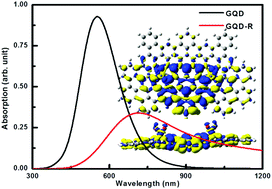The optical and electronic properties of graphene quantum dots with oxygen-containing groups: a density functional theory study†
Abstract
The effects of five types of oxygen-containing functional groups (–COOH, –COC–, –OH, –CHO, and –OCH3) on graphene quantum dots (GQDs) are investigated using time-dependent density functional theory (TD-DFT). Their absorption spectra and HOMO–LUMO gaps are quantitatively analyzed to reveal the influence of different oxygen-containing groups including their locations and quantities on the optical properties of GQDs. Compared with those on the edge of the GQD plane, oxygen-containing groups located on the surface have more evident effects on the optical properties. The calculated HOMO–LUMO gaps of pristine GQDs and edge-functionalized GQDs with –OH, –COOH, –OCH3, –CHO, and –COC– are 2.34, 2.32, 2.31, 2.30, 2.27, and 2.15 eV, respectively, whereas the HOMO–LUMO gaps of surface-functionalized GQDs with the groups above are 0.36, 0.32, 0.37, 0.39, and 1.86 eV, respectively. Interestingly, the influence of surface and edge functionalization on the HOMO–LUMO gap of GQDs is almost opposite. The absorption process is investigated along with excited state analysis, which includes the oscillator strengths, natural transition orbitals, and charge difference density. It is found that functionalization on the basal plane greatly changes the distribution of electron density in surface-functionalized GQDs.



 Please wait while we load your content...
Please wait while we load your content...